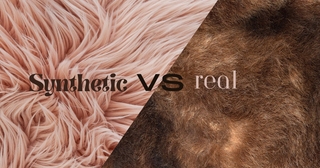In the world of fashion, fur has long been a controversial topic. The ongoing debate between synthetic and real fur raises questions about ethics, sustainability, and the overall impact on the environment. This article aims to explore the advantages, disadvantages, and environmental consequences of both synthetic and real fur, shedding light on the complexities surrounding this contentious issue.
Differentiating Real from Fake
Distinguishing real fur from its synthetic counterpart can be challenging, as advances in manufacturing have made synthetic fur increasingly realistic. However, a few key indicators can help discern between the two. Real fur usually has tapered ends, while synthetic fur often has a uniform length. Examining the base material can also provide clues, as real fur will be attached to a leather or fabric backing, whereas synthetic fur is typically attached to a synthetic material.
Warmth: Is Synthetic Fur Comparable?

Synthetic fur has come a long way in terms of imitating the warmth of real fur. Many synthetic fur products now incorporate advanced insulation technologies to provide similar levels of warmth. However, real fur generally offers superior insulation due to its natural properties, such as the air pockets between the individual hairs, which can trap heat more effectively. In extremely cold climates, real fur may still hold an advantage.
Durability: The Lifespan of Synthetic Fur

The durability of synthetic fur varies depending on its quality and the care it receives. High-quality synthetic fur can last for several years with proper maintenance, including regular cleaning and storage. However, it is important to note that synthetic fibers can wear down over time, leading to a loss of softness and resilience. Real fur, on the other hand, can endure for decades if well-maintained, making it a long-lasting investment.
Advantages and Disadvantages of Real Fur
Real fur enthusiasts argue that it possesses unique qualities that cannot be entirely replicated by synthetic alternatives. Some advantages of real fur include its exceptional warmth, natural breathability, and luxurious feel. Additionally, proponents claim that the production of real fur supports local economies and the employment of skilled artisans. However, real fur has its drawbacks.
Ethical concerns surrounding the treatment of animals in fur farming and trapping practices have sparked significant controversy. The high cost of real fur, both financially and environmentally, is another point of contention, as its production demands significant amounts of energy, water, and chemicals.
Environmental Consequences of Fur

The environmental impact of both synthetic and real fur production should be carefully considered. Real fur production involves raising animals, which requires land, feed, water, and energy resources. It also generates waste, including animal byproducts and chemicals used in processing.

On the other hand, synthetic fur is derived from petroleum-based materials, contributing to carbon emissions and reliance on non-renewable resources. Additionally, the production of synthetic fur often involves the use of chemicals and generates waste during the manufacturing process. Both types of fur have their ecological costs and should be examined critically from a sustainability standpoint.
The decision between synthetic and real fur is complex and multifaceted. While real fur offers unique qualities and supports artisanal industries, it comes with ethical concerns and significant environmental impacts. Synthetic fur provides a cruelty-free alternative, but it too has environmental consequences and may fall short in replicating the warmth and durability of real fur. Ultimately, individuals must weigh the advantages and disadvantages of each option, considering their personal values and the broader implications on animal welfare and the environment.

